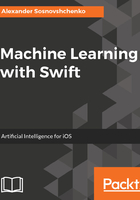
上QQ阅读APP看书,第一时间看更新
Decision tree learning pros and cons
Advantages:
- Easy to understand and interpret, perfect for visual representation. This is an example of a white box model, which closely mimics the human decision-making process.
- Can work with numerical and categorical features.
- Requires little data preprocessing: no need for one-hot encoding, dummy variables, and so on.
- Non-parametric model: no assumptions about the shape of data.
- Fast for inference.
- Feature selection happens automatically: unimportant features will not influence the result. The presence of features that depend on each other (multicollinearity) also doesn't affect the quality.
Disadvantages:
- It tends to overfit. This usually can be mitigated in one of three ways:
- Limiting tree depth
- Setting the minimal number of objects in leaves
- Tree pruning by deleting unimportant splits moving from the leaves to the root
- It is unstable—small changes in data can dramatically affect the structure of the tree and the final prediction.
- The problem with finding the globally optimal decision tree is NP-complete. That's why we use different heuristics and greedy search. Unfortunately, this approach doesn't guarantee learning the globally best tree, only locally optimal ones.
- Inflexible, in the sense that you can't incorporate a new data into them easily. If you obtained new labeled data, you should retrain the tree from scratch on the whole dataset. This makes decision trees a poor choice for any applications that require dynamic model adjustment.